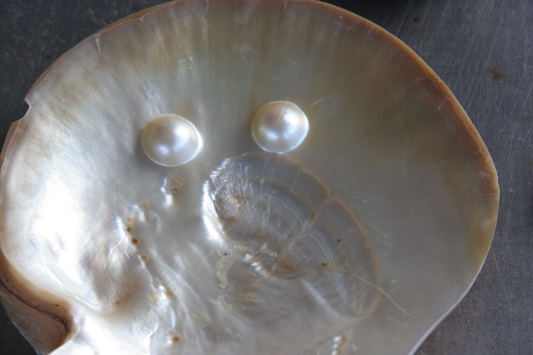Western Australia (WA) has the only significant wild stock pearl oyster fishery in the world. WA’s pearling industry is the second most valuable fishing industry to the state after rock lobster.
This industry uses Silverlip pearl oyster (Pinctada maxima) for the production of South Sea pearls, which are silver-white pearls prized around the globe. South Sea pearls are known for their smoothness, lustre and large size. They are marketed both within Australia and internationally. Other pearl oyster species are farmed on a smaller scale in WA.
Individual pearls and the pearl oyster shell (known as mother-of-pearl) are sold for use in jewellery and buttons. Pearl meat is also sold for human consumption.
The pearling industry incorporates:
- commercial fishery for the collection of wild pearl oysters
- seeding operations
- aquaculture operations for hatcheries that produce pearl oysters
- aquaculture operations for pearl farms where pearls are grown to full size.
Cultivating pearls
Divers hand-pick wild P. maxima from ocean beds in the Pilbara and Kimberley, with the main fishing grounds near Broome. The divers work from sophisticated pearling boats, on which the oysters are often seeded. Pearls are returned to the seabed in net panels.
The panels are turned regularly for three months to make the pearls round. They are then moved to the sheltered waters of farms and suspended on floating lines. It takes up to two years for the pearls to grow to desirable size and quality.
The best oysters may be seeded several times, with each pearl larger than the one before.
Hatchery-bred pearl oysters are also a part of pearl production. They are used to supplement the wild pearl oysters collected. Hatcheries in Broome and Darwin supply juvenile P. maxima to pearl farms.
Pearl oysters are carefully seeded by hatchery technicians. Seeding involves surgically inserting a bead into the oyster’s gonad. A piece of mantle (the tissue that produces nacre) from another pearl oyster is inserted with it. They are then moved to pearl farms where the pearls grow inside them. The pearls are carefully removed and sold for use in jewellery.
Stress can cause a blemish on the pearl, so the aim is to keep the oyster healthy and stress-free. Tending to oysters involves regularly removing parasites.
Every healthy oyster has a tiny pea-crab that lives inside it. The pea-crab shares the debris the oyster sucks in and probably keeps it clean. Its presence is essential for the oyster’s wellbeing, and seeding technicians are careful not to harm it.
Pearling management
The P. maxima commercial fishery is managed by the Department of Primary Industries and Regional Development (DPIRD) under the Pearling Act 1990, Pearling (General) Regulations 1991 and Ministerial guidelines.
A licence is required to fish for wild stock P. maxima. However, the fishery is a ‘limited-entry’ fishery, meaning no new licences are currently being issued. A licence or permit is also required to establish a pearl farm or hatchery.
The fishery is primarily managed using a quota system that sets a maximum number of wild stock pearl oysters that can be caught each year by the 14 licence holders.
The quota is set at a level that ensures stocks are sustainable. We closely monitor the quota through placing observers on pearling vessels and sophisticated stock assessment research.
Controls take the form of a total allowable catch (TAC), which ranges from 500,000 pearl oysters to 1.5 million in a good year. The TAC is divided into individual transferable quotas. DPIRD reviews wild stocks each year, then the TAC is set for each of the three pearl oyster fishing zones.
Hatchery-bred pearl oysters are now a part of pearl production. The value of a hatchery quota unit stays the same, but the value of wild stock quota units varies. In some seasons, high wild stock levels result in higher quotas.

